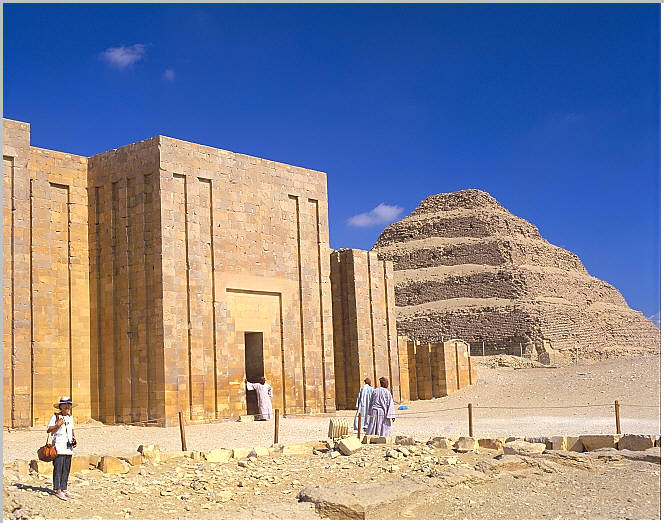The step pyramid of King Djoser sets the mood for
the whole Saqqara necropolis. Djoser was the 1st king of the 3rd dynasty and
ruled Egypt for some 20 years. His Horus name is Netjerykhet Djoser. This
is the first pyramid in Egypt and the first large stone structure in the world.
It marks a truly Monumental leap forward in architecture in Egypt and the
world. The complex is entered through the southeast corner of the reconstructed
perimeter wall. It is here also that we find the first pillars in Egypt. They
are elongated supposedly because the Egyptians were unsure how much weight
they could sustain. The step pyramid bears witness to a series of enlargements.
The structure was started as a masataba and enlarged twice. It was further
enlarged to a 4 step pyramid and finally to its current 6 step shape. On the
southeast corner of the great courtyard is a large rectangular structure.
It is decorated with friezes depicting a group Uraeuses, the sacred cobra
and protector of sovereignty. On the east side is a reconstructed royal pavilion
and probably used to hold the royal ka during the Heb-sed festival. The South
House is located just southeast of the pyramid. It was discovered in 1924
and completely reconstructed. A Khekeru frieze surmounts the door lintel,
next to which are two fluted columns. What we see today is mostly thanks to
the 70 years of work by Egyptologist Jean-Philippe Lauer.
The enclosure wall with a palace face motif, reconstructed,
here viewed from the southeast is some 10.5m tall (20 cubits). It is 1645m
long (545m N to S and 277m E to W). There are 14 gates 13 of which are false,
there being one true entrance to the complex. The recesses in the stone enclosure
were hand carved after the masonry was laid, an enormous task. There were
1680 recesses, each panel is more than 9m tall. The wall is built of fine
Tura white limestone. The step pyramid set the stage for all future royal
complexes as components of Djoser's complex are found at all subsequent pyramid
sites. In the background is the step pyramid of Djoser.

